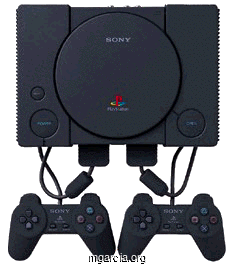|
Archived: Mike MGarcia's Games Development BlogA hobbyist Mobile/PC/Android/Console game development blogBlog | About | Contact |
Is the future Micro-consoles or Microcomputers?
Overview:
- The big 3 Console manufacturers have stagnated
- Mobile hardware and Google Android is advancing rapidly
- Convergence of Mobile HW/SW into the desktop domain
- Resurgence of the microcomputers (high-end Android appliance)
Micro-consoles
Below is my reply (based on personal thoughts and experiences) to Rob Weber’s 2014 Predictions for the Mobile Gaming Market.
He writes:
6) Micro-Consoles Will Become Extinct
It was fun to watch projects like Ouya from start to finish on Kickstarter. There was a lot of hype in 2013 but after a few failed attempts to build great micro-consoles, this trend will completely fizzle out and die in 2014.
I also have watched the micro-console space of 2013 and the whole buzz around android gaming.
The first wave of micro-consoles was Ouya and playjam’s gamestick.
Both of which used 2011-12 GPU/CPU, 1G RAM and 8GB of on board storage.
These were interesting to me but I didn’t want to spend $100USD each
year on out of date hardware with a throw away controller, I didn’t see
the point.
Surprisingly, these two are still being sold at the same price with the same hardware in 2014! wow!
Add to this, their overpriced, limited proprietary ecosystems and you have a recipe for a disaster.

The top row, Ouya and Gamestick are both low-end micro-consoles.
The Mad Catz MOJO, bottom left, is a high-end micro-console microcomputer.
The Nvidia Shield, bottom right, is a hand-held with HDMI out and obviously not a micro-console by definition.
These two low-end, cheap units (top row) are really only good for running the apps they sell in their stores: games.
Those expecting a fuller and open Android experience would have rooted
the device and side loaded apps, ie google play, but obviously this is
not it’s intended use.
Unfortunately, you are still bound to that older hardware, so it’s performance and usage would be limiting.
Also, the hardware may have been subsidized by sales in their ecosystem, which means they’re business model is now broken.
This could explain why Ouya 2 still hasn’t been mentioned.
So do these gaming micro-consoles want to follow in the foot steps of
the ‘big three’ (Sony, Microsoft, Nintendo) console manufacturers?
Consoles
Yes, micro-consoles want the space under the TV taken up by the big three:
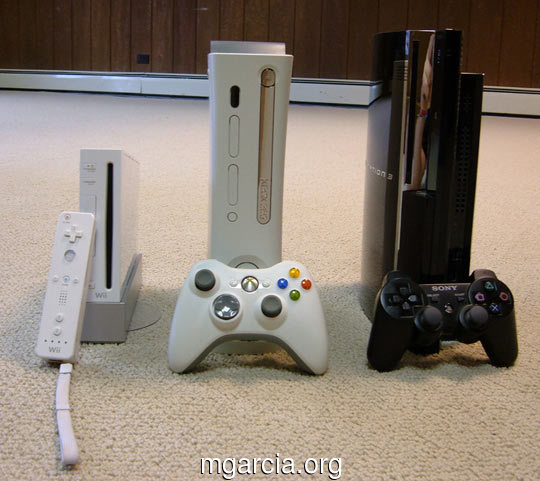
For the most part, these consoles haven’t evolved from their original conception.
Even though they have always wanted to be a TV Topset box, they never
really succeeded (I think because of their proprietary nature).
Sure they added a web browser and a media player, but all very limited experiences.
And the same is true with these cheap micro-consoles.
I believe console manufacturers have stagnated, ie instead of advancing 3D hardware they use desktop hardware.
But what else is there if cheap micro-consoles are based on old hardware?
Mobile hardware
Mobile phone hardware has been innovating at a mind blowing rate!
The Nvidia Tegra 4 is graphically better then a xBox, Sony Playstation 2 or a Sony PSP.
But Nvidia’s newest chip the Tegra K1, has a GPU more powerful then a Sony PS3 or a Xbox360!
And it’s powered by a A15 quad core (or a 64bit dual core) 2.5Ghz CPU!
The K1 runs on 5 watts of power, which is very, very energy efficient.
The Tegra 3 was out of date in 2012, but the Tegra 4 in 2014 is
comparable to the K1 in performance with it’s similar GPU/CPU
architecture.
Logan was the project name for the Tegra K1 (performance axis is not correct):
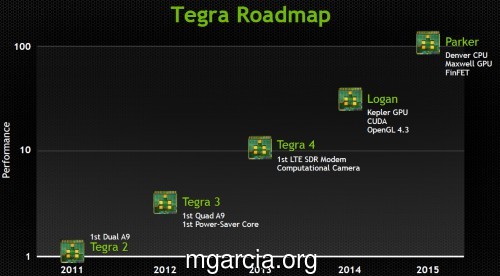
To compare the Tegra 4 with the K1 see Tom’s Hardware review of the Lenovo thinkvision 28.
But this is just Nvidia, there is also Samsung, Texas instruments and Apple advancing their hardware technology.
So, what’s the point to all this power in the palm of your hand?
Convergence
This power facilitates the convergence of separate devices, ‘converging’ into a single device.
For example a music player, digital camera and navigation unit can now all be replaced with a single mobile phone.
Following this trend, I can see desktop computers becoming less
important at home and other devices more relevant (and this is why I
believe valve is trying SteamBox).
Here we can see the jump from mobile hardware to the adoption of desktop 3D graphic technology:

But hardware can’t do it by itself, you also need a good operating system and software support.
Google Android
Why Android?
iOS while open to developers, is very critical of application it allows.
Their philosophy to make simplicity for the masses, not software and hardware openness.
Windows and Ubuntu (Linux) is also developing mobile/desktop ecosystems but still infant.
Android is an (open) operating system with multi-platform hardware support.
It’s own application ecosystem, called google play store has free and
non free software which ranges from 99c to $6+, compared to desktop or
games consoles their prices are very cheap but aren’t as feature rich,
but this is changing due to competition!
And it’s not just games, applications range from media
(movie/music/books), productivity (authoring, graphics, design, etc),
internet and system tools to name a few.

Android has also been very innovative, introducing more hardware
support (ie native keyboard, mouse, game controller) and software
features like game services.
These innovations are then used by developers to create better
applications, for example mobile games are starting to include support
for physical controllers.
Generally speaking, Android has no backward compatibility issues like game consoles and desktops have.
The other benefit of Android is the Google play store’s philosophy of
buying applications once and use them on multiple devices, ie mobile,
tablet and possibly netbooks, laptops and TV’s.
Android, right now is capable of providing a desktop experience which I
liken it to that of windows in the early 1990’s: usable, maturing, open
and with a lot of developers.
So now you have a small box with the power of a laptop, what do you do with it?
Resurgence of microcomputers
Before computers were Personal Computers (PC), in the late 1970’s to
late 1980’s microcomputers were very common, ie the Commodore 64, TRS-80
and the spectrum to name a few.
These were typically an 8 bit microprocessor (not a CPU) built into a keyboard and used with a television as a monitor.
Advertised (mostly due to price) as family computers, it had software
ranging from productivity and creative tools through to games and were
“easy” to use.
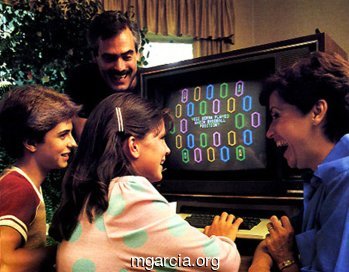
Fast-forward to today, we have many computing devices which have
television connectivity, ie tablets, laptops, phones, etc, but there is
only one which is always connected, and that’s the gaming consoles!
With so much digital content, it doesn’t make sense to be limited to
mainly games in a closed ecosystem, running on locked down hardware.
Current or newer generations of mobile hardware with Android can provide
a microcomputer experience which is halve the price of a low-end
desktop, easier to use and can also serve as a family TV PC.
The Future: highend Android appliance
The first Micro-consoles (Ouya and Gamestick), I see as false starts.
Apart from their limited proprietary ecosystems, their biggest limiting factor is their redundant hardware.
Unfortunately, they have stereotyped the term micro-consoles in mainstream as cheap, limited gaming devices.
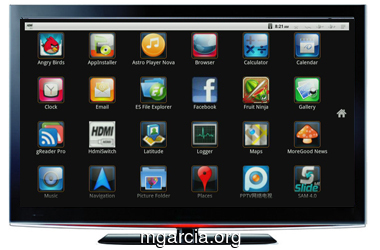
In the not so distant future we will see Android devices being sold next to desktops in stores as capable budget PC’s.
I believe these devices will be a barebones, stand alone box with a HDMI cable.
The purchaser will need a keyboard, mouse, game controller (USB or Bluetooth) and a television or monitor.
Perhaps bundled like the old 8bit microcomputers with a keyboard/mouse/gamepad/software starter pack.
I also see manufacturers having product recycling schemes and take back programs, perhaps using a swappable board and offering a small discount as incentives for upgrading to newer hardware (boards).
I would like to see these units powered via the TV, ie USB port and HDMI, optionally having a small internal battery, avoiding the power adapter.
Final thoughts
I am convinced this is the case because of my personal experience with my Mad Catz MOJO, an Android high-end micro-console microcomputer.
I used my laptop (rather then turning on the desktop) mainly for simple
general things like emails, web browsing, chat and reading/writing
documents etc.
After using the MOJO with a full USB keyboard and mouse on the coffee table for the past week my laptop has been made redundant.
As a desktop/laptop replacement, The MOJO has great performance with superb multi-tasking of applications.
This same experience is very quickly demonstrated in the Newegg.com video of the MOJO.
The most common issue with the Mad catz MOJO out there is the price issue.
If you compare a low-end desktop to a high-end Android appliance it becomes more comparable.
Plus you also get the great Mad Catz CTRLR and travel clip included.
On my Youtube channel I’ve been recording gameplay of the MOJO, but soon I’ll do some desktop related videos to show what I mean.
Comments now disabled.
For comments or questions, please post on twitter @mgarcia_org.
